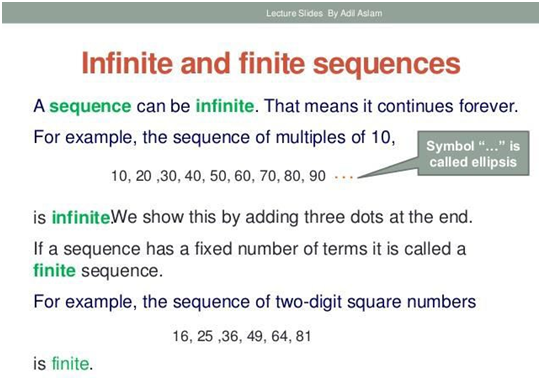CLASS-6
SETS - FINITE & INFINITE SETS
FINITE & INFINITE SETS -
FINITE SET -
A finite set is a collection of distinct elements or objects that has a specific, countable number of members. In other words, a finite set contains a definite, limited number of elements.
For example, consider the set of natural numbers less than 10: {1, 2, 3, 4, 5, 6, 7, 8, 9}. This is a finite set because it has a clear and limited number of elements (in this case, 9).
In contrast, an infinite set has an unlimited number of elements. For example, the set of all natural numbers {1, 2, 3, 4, ...} is infinite because it goes on forever.
- The set of natural numbers less than 10: {1, 2, 3, 4, 5, 6, 7, 8, 9}.
- The set of colors in a rainbow: {red, orange, yellow, green, blue, indigo, violet}.
- The set of planets in our solar system: {Mercury, Venus, Earth, Mars, Jupiter, Saturn, Uranus, Neptune}.
Consider the set of natural numbers less than 10: {1, 2, 3, 4, 5, 6, 7, 8, 9}. This is a finite set because it contains exactly 9 elements.
In contrast, an infinite set is a set with an uncountable number of elements, like the set of all natural numbers: {1, 2, 3, 4, ...}, which goes on forever.
It's worth noting that the concept of finite and infinite sets is fundamental in mathematics and has applications in various branches of mathematics, including set theory, combinatorics, and analysis.

INFINITE SET -
An infinite set is a set that contains an uncountable or limitless number of elements. In other words, it goes on forever.
For example, the set of all natural numbers {1, 2, 3, 4, 5, ...} is an infinite set because there is no end to the list of natural numbers. Similarly, the set of all integers {..., -3, -2, -1, 0, 1, 2, 3, ...} is infinite because it includes all positive and negative whole numbers.
One of the most well-known examples of an infinite set is the set of natural numbers, denoted by ℕ. It includes all positive whole numbers, starting from 1 and continuing indefinitely: ℕ = {1, 2, 3, 4, 5, ...}.
Another example of an infinite set is the set of integers, ℤ, which includes all positive and negative whole numbers and zero: ℤ = {..., -3, -2, -1, 0, 1, 2, 3, ...}.
Sets like the set of real numbers (ℝ), the set of rational numbers (ℚ), and the set of irrational numbers (the numbers that cannot be expressed as fractions of integers) are also infinite sets because they have an uncountable number of elements.
Another example is the set of all real numbers, which includes not only integers and fractions but also irrational numbers like π (pi) and √2 (the square root of 2). This set is vast and continuous, making it infinite.
For example, the set of all natural numbers {1, 2, 3, 4, ...} is an infinite set because it continues indefinitely, with no upper bound.
Another example is the set of all real numbers between 0 and 1, which includes numbers like 0.1, 0.01, 0.001, and so on. This set is infinite because there are infinitely many real numbers between 0 and 1.
It's important to note that while infinite sets can be quite large, they can still have different sizes in a mathematical sense. For example, there are more real numbers between 0 and 1 than there are natural numbers, even though both sets are infinite. This concept is explored in the field of set theory.